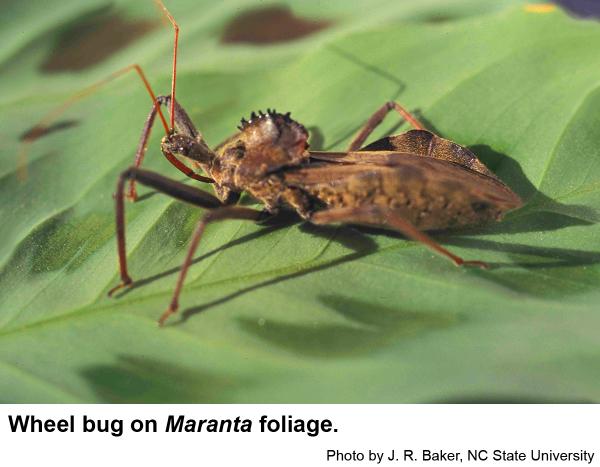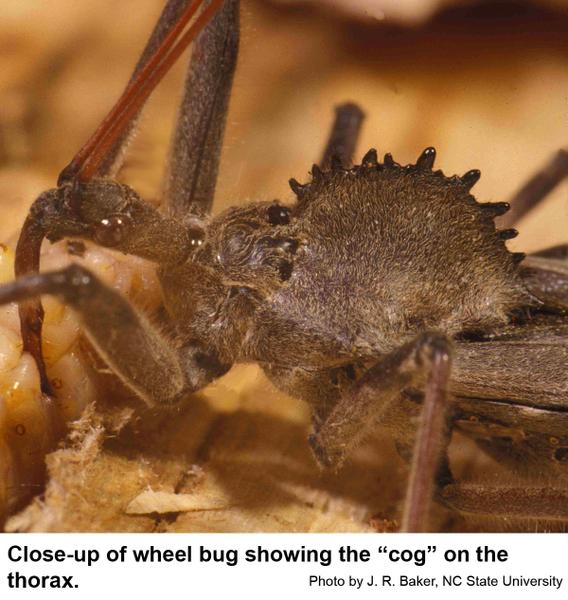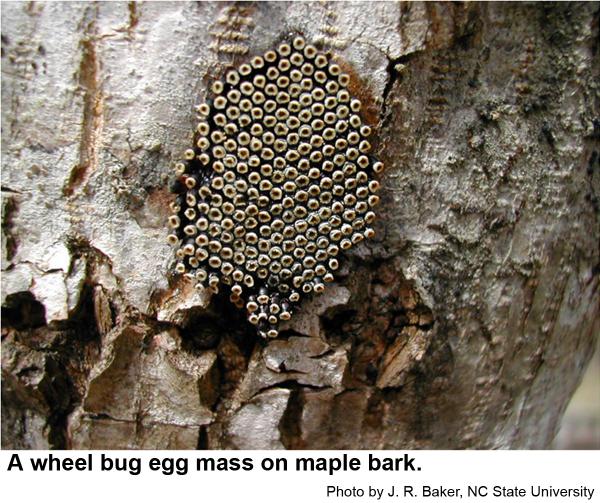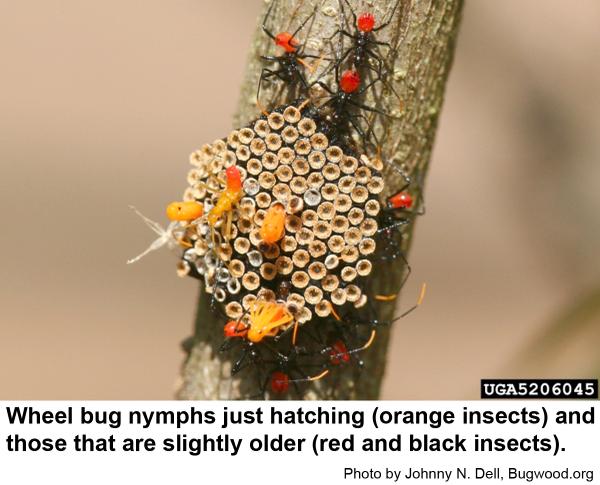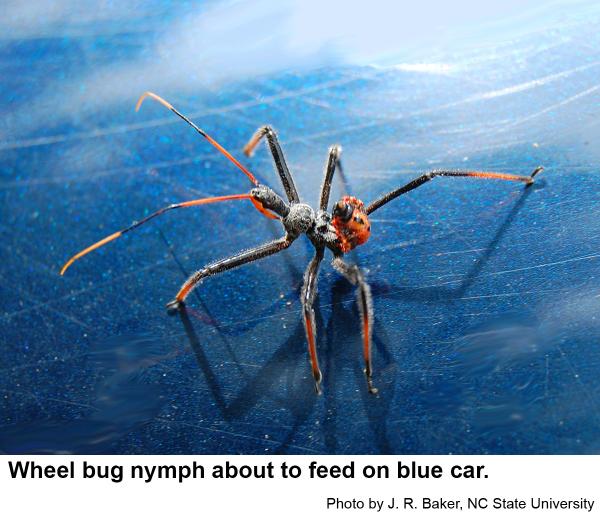General Information
Wheel bugs are large (up to 13⁄8 inches), brown to gray bugs with a dark, shining area of the wings over the rear of the body. Antennae are thin and rusty brown. A conspicuous raised half "cogwheel" on the thorax distinguishes this bug from all others. Adults are striking red when they first molt, but soon take on the cryptic gray coloration. The eggs are dark brown and about 1⁄8 inch long with a tan rim around the top. The top has a dark brown center. The egg is bottle shaped and is glued down in a mass of 42 to 182 eggs in an irregular, raised patch. Young bug nymphs are bright red with black markings, whereas older nymphs are colored like adults. Nymphs grow from about 1⁄8 to 1 inch.
Biology
Wheel bugs occur throughout North Carolina. They feed voraciously on caterpillars, such as the fall webworm and imported cabbageworm. Wheel bugs have been reported to feed on locust borer adults on goldenrod, Japanese beetles, eleven-spotted cucumber beetles, leafmining beetle larvae inside the leaf and other insects. Female wheel bugs sometimes kill and feed on male wheel bugs after mating. Wheel bug nymphs feed on aphids and other small insects.
Wheel bugs feed by piercing the host and injecting a potent saliva into the prey. The saliva contains enzymes that quickly subdue the prey and then digest the tissues inside. The wheel bug then sucks this digested liquid from the prey as it shrivels up. If handled carelessly, wheel bugs may inflict a painful bite on people. Such a bite has been described as "much more powerful than a hornet or wasp sting". Injury from a wheel bug bite takes about 10 days to heal and leaves a small scar.
Female wheel bugs lay masses of 42 to 182 eggs by gluing them to bark or some object. Wheel bugs overwinter as eggs. Tiny wheel bug nymphs hatch in April and May and begin to feed on aphids and other small insects. As nymphs develop through five instars (stages), they become larger and thus capable of attacking larger prey. Adult wheel bugs can feed on large hornworm caterpillars. We have one generation per year. Wheel bugs are not extremely abundant because, when prey is scarce, wheel bugs feed on other wheel bugs, and female wheel bugs commonly feed on male wheel bugs after mating. Because of their large size and bizarre half "cogwheel" on the thorax, wheel bugs are often noticed by the public. Fortunately most amateur collectors are sufficiently impressed by the ferocious appearance of wheel bugs to avoid being bitten.
Control
Because wheel bugs prey upon plant pests and because wheel bug numbers are usually low, chemical control of wheel bugs is not warranted. Direct handling of wheel bugs should be avoided as they can inflict a painful bite. If these bugs are a nuisance, they can be safely dislodged with a stick, brush or some other object, trampled underfoot, or relocated.
Other Resources
- Common name: wheel bug, scientific name: Arilus cristatus (Linnaeus) (Insecta: Hemiptera: Reduviidae). Mead, F. W. 1999 (revised 2014). Featured Creatures. Entomology & Nematology, FDACS/DPI, EDIS.
- Studies on biology of the Reduviidae of America north of Mexico. Readio, P.A. 1927. University of Kansas Science Bulletin. 17, 291 pp.
- The Wheel Bug. Bessin, R. 2003. Entomology, University of Kentucky ENTfact 426.
- NC State Extension Plant Pathology Publications
- NC State Horticultural Science Publications
- North Carolina Agricultural Chemicals Manual
For assistance with a specific problem, contact your local N.C. Cooperative Extension center.
Publication date: May 1, 1997
Reviewed/Revised: Oct. 18, 2019
N.C. Cooperative Extension prohibits discrimination and harassment regardless of age, color, disability, family and marital status, gender identity, national origin, political beliefs, race, religion, sex (including pregnancy), sexual orientation and veteran status.

